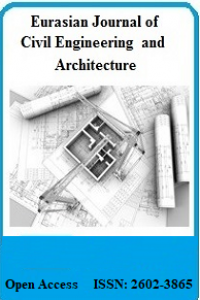AN EVALUATION OF THREE SOLAR ARCHITECTURE HOUSING PROJECTS USING THE ANALYTIC HIERARCHY PROCESS (AHP)
AN EVALUATION OF THREE SOLAR ARCHITECTURE HOUSING PROJECTS USING THE ANALYTIC HIERARCHY PROCESS (AHP)
ABSTRACTNegative effects stemming from global warming all over the world, depletion of fossil fuels, technological developments and transformation of building living spaces have not only increased the need for energy but enhanced the need for new energy resources. Within this environment, sustainable, clean and renewable energy resources, and the utilization of these resources, need to be expanded. It is necessary to take advantage of solar energy both worldwide and in Turkey throughout the four seasons to produce profitable architectural methods at the maximum rate. Accordingly, a study was made in which a group of students modified their housing projects from a previous semester to use solar architecture which ensures maximum benefit from solar energy with the aim of gaining experience of solar architectural methods. The transformation of three different housing projects into solar architecture to benefit from the solar architecture has been performed using the methods in architecture. Identifying which is the most efficient project providing the maximum benefit from the three different solar architecture projects will demonstrate the success of the solar energy methods used. Within this context, the Analytic Hierarchy Process (AHP) has been used to decide which is the most successful solar architecture project and solar energy system.
Keywords:
Solar architecture, Solar Energy System Decision,
___
- REFERENCES
- [1] Şimşek, S. 2009. Güneşle Tasarım, TOL Mimarlık Kültürü Dergisi, Mimarlar Odası Kayseri Şubesi, Sayı 7, s.82.
- [2] Yüre,T. 2007. “Güneş Enerjisinden Edilgen Sistem Yararlanmada Güneş Odası Ekleme Yönteminin İç Ortam Sıcaklığına Etkisinin İncelenmesi İstanbul Örneği”, Yüksek Lisans Tezi, Yıldız Teknik Üniversitesi, Fen Bilimleri Enstitüsü, İstanbul.
- [3] Demircan, R.K. and Gültekin, A.B. 2015. Binalarda Pasif Ve Aktif Güneş Sistemlerinin İncelenmesi Investıgatıon of Passıve And Actıve Solar Systems In Buıldıngs, 2. International Sustainable Buildings Sysmposium.
- [4] url 1. http://surdurulebilirmimari.blogspot.com/2012/09/surdurulebilir-mimaride-kullanılan-pasif.html (Erişim tarihi 11.01.2019).
- [5] Alparslan, B. 2010. “Ekolojik Yapı Tasarım Ölçütleri Kapsamında Ankara’da Örnek Bir Yapı Tasarımı ve Değerlendirmesi”, Yüksek Lisans Tezi, Gazi Üniversitesi, Fen Bilimleri Enstitüsü, Ankara.
- [6] Mazria, E. 1979. The Passive Solar Energy Book, USA.
- [7] Demirbilek, N. 1999. Mimarlıkta Pasif Sistemlerden Yararlanma ve Korunma, Güneş Günü Sempozyumu Bildiriler Kitabı, Kayseri.
- [8] Özdoğan, H.P. 2005. “Ekolojik Binalarda Bina Kabuğunda Kullanılan Fotovoltaik Panellerin Tasarım Bağlamında İncelenmesi”, Yüksek Lisans Tezi, Yıldız Teknik Üniversitesi, Fen Bilimleri Enstitüsü, İstanbul.
- [9] url 2. https://antrak.org.tr/blog/gune%C5%9F-panelleri-icin-basit-bir-regulator-devresi/ (Erişim tarihi 26.02.2019)
- [10] Saaty, T.L. 1980. “The Analytical Hiyerarchy Process”, Mc Grow-Hill Company,New York.
- [11] Dağdeviren, M., Akay, D., Kurt, M. 2004. İş değerlendirme Sürecinde Analitik Hiyerarşi Prosesi ve Uygulaması, Gazi Üniversitesi Mühendislik – Mimarlık Fakültesi Dergisi, 19 (2), 131- 138.
- [12] Toksarı, M. and Toksarı, M.D. 2011. Bulanık Analitik Hiyerarşi Prosesi (AHP) yaklaşımı kullanılarak hedef pazarın belirlenmesi, ODTÜ Geliştirme Dergisi, 38, Ankara.
- [13] Dağdeviren, M. and Eren, T. 2001. Tedarikçi Firma Seçiminde Analitik Hiyerarşi Prosesi ve 0-1 Hedef Proğramlama Yöntemlerinin Kullanılması, Gazi Üniversitesi Mühendislik – Mimarlık Fakültesi Dergisi, 16 (2), 41-52.
- [14] Chandran, B. 2005. “Linear Programming Models For Estimating Weights In The Analytic Hierarchy Process”, Computers & Operations Research 32.
- Başlangıç: 2017
- Yayıncı: Serkan ŞAHİNKAYA
